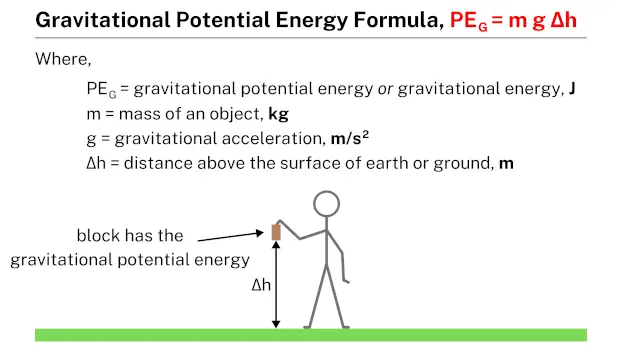Gravitational energy, also known as gravitational potential energy, refers to the energy an object possesses by virtue of its position in a gravitational field. It is directly related to the object’s height above a reference point. The higher the object is positioned, the greater its gravitational potential energy. This energy arises from the gravitational force between the object and the Earth (or any other massive body). Objects in elevated positions possess gravitational energy because they have the potential to fall or move towards the Earth, converting their potential energy into other forms, such as kinetic energy. For example, a raised weight or a ball positioned on a hilltop has gravitational potential energy that can be converted into kinetic energy as it falls or rolls downhill.
Examples
Motorcycle

A motorcycle jumping from a hill exhibits gravitational potential energy during the ascent. As the motorcycle climbs the hill, it gains potential energy due to its increased height. When the motorcycle leaves the ground to jump, the stored potential energy is converted into kinetic energy, propelling the motorcycle through the air. The descent of the motorcycle after the jump further illustrates the continuous conversion between gravitational potential energy and kinetic energy. Motorcycle jumps from hills showcase the dynamic application of gravitational potential energy in the realm of extreme sports.
Bookshelf

Books resting on the top of a bookshelf possess gravitational potential energy. The potential energy is a result of the books being elevated above the ground. The amount of potential energy depends on the height of the bookshelf and the mass of the books. If the books were to fall, the stored potential energy would be converted into kinetic energy as they descend. This scenario demonstrates how everyday objects, like books on a shelf, exhibit gravitational potential energy based on their position in relation to the Earth’s surface.
Roller coaster

A roller coaster showcases the interplay between gravitational potential energy and kinetic energy. At the highest point of the roller coaster track, the coaster cars have maximum gravitational potential energy. As the cars descend, the potential energy is converted into kinetic energy, resulting in high-speed motion. The thrilling dips and loops of a roller coaster illustrate the dynamic transfer between gravitational potential energy and kinetic energy throughout the ride, providing riders with an exhilarating experience.
Crane

When a crane lifts a weight, gravitational potential energy is at play. As the crane elevates the weight off the ground, it gains potential energy due to its increased height in the Earth’s gravitational field. The amount of potential energy stored in the lifted weight depends on its mass and the height to which it is raised. This stored potential energy can be released by lowering the weight or allowing it to descend, converting the gravitational potential energy back into kinetic energy. The controlled lifting and lowering of weights by cranes demonstrate the practical application of gravitational potential energy in various industries, showcasing the efficiency and versatility of such lifting systems.
Wrecking ball

A wrecking ball suspended from a crane demonstrates gravitational potential energy. When the wrecking ball is lifted to a certain height, it gains gravitational potential energy due to its elevated position in the Earth’s gravitational field. The potential energy stored in the wrecking ball is then converted into kinetic energy as the ball swings and is released to demolish structures. The controlled release of gravitational potential energy enables the wrecking ball to perform destructive work during demolition processes.
Pebble

Lifting a pebble in hand creates gravitational potential energy. When the pebble is raised above the ground, it gains potential energy due to its elevated position in the Earth’s gravitational field. The potential energy stored in the pebble can be released by letting it fall, converting the potential energy into kinetic energy. This simple action illustrates the fundamental relationship between elevation and gravitational potential energy in everyday objects.
Large rock

A large rock positioned on the edge of a cliff or slope possesses gravitational potential energy. The potential energy is a result of the rock’s elevated position in the Earth’s gravitational field. If the rock were to fall, the stored potential energy would be converted into kinetic energy as the rock descends. The amount of potential energy depends on the rock’s mass and the height of the cliff or slope. The concept is fundamental to understanding the potential danger associated with unstable rocks positioned on elevated surfaces.
Apple

A hanging fruit, such as an apple on a tree, exhibits gravitational potential energy when elevated above the ground. As the fruit hangs from the tree branch, it gains potential energy due to its position in the Earth’s gravitational field. When the fruit falls or is plucked, the potential energy is converted into kinetic energy as it descends. The fall of the fruit is governed by the principles of gravitational acceleration, and the kinetic energy gained allows the fruit to reach the ground. Hanging fruit demonstrates the natural occurrence of gravitational potential energy in everyday situations.
Garden slide

A child sitting at the top of a garden slide possesses gravitational potential energy. The potential energy is determined by the height of the slide and the mass of the child. As the child starts to slide down, the potential energy is gradually converted into kinetic energy, resulting in the child’s descent down the slide. The enjoyment of the sliding experience is a playful illustration of the gravitational potential energy concept in a familiar and recreational setting.
Waterfall

A waterfall is a natural example of the conversion between gravitational potential energy and kinetic energy. Water at the top of a waterfall has gravitational potential energy due to its elevated position. As the water flows downward, this potential energy is transformed into kinetic energy, creating the dynamic and visually stunning motion of a waterfall. The height of the waterfall contributes to the force and velocity of the falling water, showcasing the continuous conversion between gravitational potential energy and kinetic energy in the natural world.
Formula

The gravitational potential energy formula, denoted as PEG = m g Δh, establishes a relationship between the gravitational potential energy (PEG) of an object, its mass (m), gravitational acceleration (g), and the vertical displacement (Δh). By utilizing this formula, one can accurately calculate the magnitude of gravitational potential energy stored in an object, taking into account its mass, gravitational acceleration, and the vertical distance it has been raised.
Practice problems
Problem #1
Determine the gravitational potential energy of a 10 kg box that has been lifted to a height of 5 m above the ground. Use a gravitational acceleration value of g = 9.81 m/s2.
Solution
Given data:
- Gravitational potential energy of a box, PEG = ?
- Mass of a box, m = 10 kg
- Distance above the surface of ground, Δh = 5 m
- Gravitational acceleration, g = 9.81 m/s2
Applying the formula:
- PEG = m g Δh
- PEG = 10 × 9.81 × 5
- PEG = 490.5 J
Therefore, the gravitational potential energy of a box is 490.5 J.
Problem #2
Calculate the gravitational potential energy of a trolley weighing 5 kg that has been lifted to a height of 15 m above the ground. Use a gravitational acceleration value of g = 9.81 m/s2.
Solution
Given data:
- Gravitational potential energy of a trolley, PEG = ?
- Mass of a trolley, m = 5 kg
- Distance above the surface of ground, Δh = 15 m
- Gravitational acceleration, g = 9.81 m/s2
Applying the formula:
- PEG = m g Δh
- PEG = 5 × 9.81 × 15
- PEG = 735.75 J
Therefore, the gravitational potential energy of a trolley is 735.75 J.
Problem #3
Find the gravitational potential energy of a 24 kg wooden block that has been lifted to a height of 20 m above the floor. Use a gravitational acceleration value of g = 9.81 m/s2.
Solution
Given data:
- Gravitational potential energy of a wooden block, PEG = ?
- Mass of a wooden block, m = 24 kg
- Distance above the surface of ground, Δh = 20 m
- Gravitational acceleration, g = 9.81 m/s2
Applying the formula:
- PEG = m g Δh
- PEG = 24 × 9.81 × 20
- PEG = 4708.8 J
Therefore, the gravitational potential energy of a wooden block is 4708.8 J.
Problem #4
Determine the gravitational potential energy of a football thrown upwards by a player to a height of 8 m above the ground. The football has a mass of 450 g. Use a gravitational acceleration value of g = 9.81 m/s2.
Solution
Given data:
- Gravitational potential energy of a football, PEG = ?
- Distance above the surface of ground, Δh = 8 m
- Mass of a football, m = 450 g = 0.45 kg
- Gravitational acceleration, g = 9.81 m/s2
Applying the formula:
- PEG = m g Δh
- PEG = 0.45 × 9.81 × 8
- PEG = 35.31 J
Therefore, the gravitational potential energy of a football is 35.31 J.
Related
More topics
- Thermal energy
- Potential energy
- Kinetic energy
- Chemical energy
- Electrical energy
- Geothermal energy
- Radiant energy
- Sound energy
- Elastic energy
- Gravitational energy
- Mechanical energy
- Electric potential energy
- Rotational energy
- Photon energy
External links
- https://www.solarschools.net/knowledge-bank/energy/types/gravitational
- https://lambdageeks.com/examples-of-gravitational-potential-energy/
- https://www.studysmarter.us/explanations/physics/energy-physics/gravitational-potential-energy/
- https://study.com/learn/lesson/what-is-gravitational-potential-energy.html
Deep
Learnool.com was founded by Deep Rana, who is a mechanical engineer by profession and a blogger by passion. He has a good conceptual knowledge on different educational topics and he provides the same on this website. He loves to learn something new everyday and believes that the best utilization of free time is developing a new skill.
